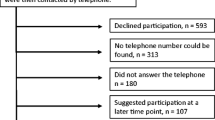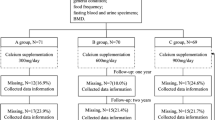Abstract
Summary
The effects of milk intake on bone health are not clear in elderly Asian men with low dietary calcium intake. This study showed that greater milk intake is associated with lower bone turnover, higher bone density, and higher bone microarchitecture index in community-dwelling elderly Japanese men.
Introduction
The consumption of milk or dairy products is widely recommended for maintaining bone health regardless of gender or age. However, little evidence exists on the beneficial effects of milk intake on bone health in elderly Japanese men characterized with relatively low dietary calcium intake. Here we examined whether or not greater milk intake was associated with lower bone turnover, higher bone density, and stronger bone microarchitecture in community-dwelling elderly Japanese men.
Methods
Interviews were conducted to obtain information on medical history and lifestyle, including the amount of habitual milk intake, nutrient intake calculations based on a 1-week food diary, and measurements of areal bone mineral density (aBMD) at the lumbar spine (LS), total hip (TH), and femoral neck (FN) by dual-energy x-ray absorptiometry (DXA), trabecular bone score (TBS) using DXA images at LS, and biochemical markers of bone turnover in sera. Participants with a history of diseases or medications that affect bone metabolism, or with missing data, were excluded from the analysis.
Results
The median intake of milk in the 1479 participants (mean age, 73.0 ± 5.1 years) was one glass of milk per day. Bone turnover markers showed a decreasing trend (p < 0.05) and aBMD at TH (p = 0.0019) and FN (p = 0.0057) and TBS (p = 0.0017) showed increasing trends with greater milk intake after adjusting for demographic and behavioral confounding factors. This association was attenuated after further adjusting for nutrient intake, in particular, calcium intake.
Conclusions
Greater milk intake was associated with lower bone turnover, higher aBMD, and higher TBS in community-dwelling elderly Japanese men.

Similar content being viewed by others
References
Cooper C, Cole ZA, Holroyd CR, Earl SC, Harvey NC, Dennison EM, Melton LJ, Cummings SR, Kanis JA, IOF CSA Working Group on Fracture Epidemiology (2011) Secular trends in the incidence of hip and other osteoporotic fractures. Osteoporos Int 22:1277–1288
Hagino H, Furukawa K, Fujiwara S, Okano T, Katagiri H, Yamamoto K, Teshima R (2009) Recent trends in the incidence and lifetime risk of hip fracture in Tottori, Japan. Osteoporos Int 20:543–548
Cooper C, Campion G, Melton LJ 3rd (1992) Hip fractures in the elderly: a world-wide projection. Osteoporos Int 2:285–289
Heany RP (2000) Calcium, dairy products and osteoporosis. J Am Col Nutr 19:83S–99S
Weinsier RL, Krumdieck CL (2000) Dairy foods and bone health: examination of the evidence. Am J Clin Nutr 72:681–689
National Institute of Health and Nutrition (2013) The National Health and Nutrition Survey Japan, 2010. Tokyo, Daiichi shuppan, pp 52–63 (in Japanese)
Kim KM, Choi SH, Lim S, Moon JH, Kim JH, Kim SW, Jang HC, Shin CS (2014) Interactions between dietary calcium intake and bone mineral density or bone geometry in a low calcium intake population (KNHANES IV 2008–2010). J Clin Endocrinol Metab 99:2409–2417
Pongchaiyakul C, Charoenkiatkul S, Kosulwat V, Rojroongwasinkul N, Rajatanavin R (2008) Dietary calcium intake among rural Thais in northeastern Thailand. J Med Assoc Thai 91:153–158
Harinarayan CV, Ramalakshmi T, Prasad UV, Sudhakar D, Srinivasarao PV, Sarma KV, Kumar EG (2007) High prevalence of low dietary calcium, high phytate consumption, and vitamin D deficiency in healthy south Indians. Am J Clin Nutr 85:1062–1067
Iki M, Fujita Y, Tamaki J Kouda K, Yura A, Kadowaki E, Sato Y, Moon JS, Okamoto N, Kurumatani N; Study Group for Functioning Capacity and Quality of Life in Elderly Japanese (Fujiwara-kyo Study Group) (2009) Design and baseline characteristics of a prospective cohort study for determinants of osteoporotic fracture in community-dwelling elderly Japanese men: the Fujiwara-kyo osteoporosis risk in men (FORMEN) study. BMC Musculoskelet Disord 10:165
Craig CL, Marshall AL, Sjostrom M, Bauman AE, Booth ML, Ainsworth BE, Pratt M, Ekelund U, Yngve A, Sallis JF, Oja P (2003) International physical activity questionnaire: 12-country reliability and validity. Med Sci Sports Exerc 35:1381–1395
Science and Technology Agency Japanese Ministry of Education, Culture, Sports, Science and Technology (2010) Standard tables of food composition in Japan (2010 edition). Official Gazette Co-operation of Japan, Tokyo (in Japanese)
Kawaguchi H, Matsumoto T, Kurokawa T, Orimo H, Mizunashi K, Takuwa Y, Niimi H, Shiraki M, Ohara T, Shishiba Y, Tsuchiya Y, Takahashi H, Takatsuki K, Seino Y, Morii H, Fujita T, Okamoto S, Ogata E (1990) Serum levels of BGP determined by two-site immunoradiometric assay (IRMA) using monoclonal antibodies. Clin Endocrinol 38:1291–1296 (in Japanese)
Melkko J, Kauppila S, Niemi S, Risteli L, Haukipuro K, Jukkola A, Risteli J (1996) Immunoassay for intact amino-terminal propeptide of human type I procollagen. Clin Chem 42:947–954
Rosen HN, Moses AC, Garber J, Iloputaife ID, Ross DS, Lee SL, Greenspan SL (2000) Serum CTX: a new marker of bone resorption that shows treatment effect more often than other markers because of low coefficient of variability and large changes with bisphosphonate therapy. Calcif Tissue Int 66:100–103
Ishizawa Y, Inaba M, Ishii K, Yamashita H, Miki T, Goto H, Yamada S, Chaki O, Kurasawa K, Mochiduki Y (2005) Evaluation of newly developed kit for measurement of bone-specific tartrate-resistant acid phosphatase in blood. Igaku Yakugaku 54:709–717 (in Japanese)
Orimo H, Sugioka Y, Fukunaga M, Muto Y, Hotokebuchi T, Gorai I, Nakamura T, Kushida K, Tanaka H, Ikai T, Oh-hashi Y (1998) Diagnostic criteria of primary osteoporosis. J Bone Miner Metab 16:139–150
Lewiecki EM, Gordon CM, Baim S, Leonard MB, Bishop NJ, Bianchi ML, Kalkwarf HJ, Langman CB, Plotkin H, Rauch F, Zemel BS, Binkley N, Bilezikian JP, Kendler DL, Hans DB, Silverman S (2008) International Society for Clinical Densitometry 2007 Adult and Pediatric Official Positions. Bone 43:1115–1121
Iki M, Kagamimori S, Kagawa Y, Matsuzaki T, Yoneshima H, Marumo F (2001) Bone mineral density of the spine, hip and distal forearm in representative samples of the Japanese female population: Japanese Population-Based Osteoporosis (JPOS) Study. Osteoporos Int 12:529–537
Kanis JA, Melton LJ 3rd, Christiansen C, Johnston CC, Khaltaev NJ (1994) The diagnosis of osteoporosis. J Bone Miner Res 9:1137–1141
Winzenrieth R, Michelet F, Hans D (2013) Three-dimensional (3D) microarchitecture correlations with 2D projection image gray-level variations assessed by trabecular bone score using high-resolution computed tomographic acquisitions: effects of resolution and noise. J Clin Densitomet 16:287–296
Hans D, Barthe N, Boutroy S, Pothuaud L, Winzenrieth R, Krieg MA (2011) Correlations between trabecular bone score, measured using anteroposterior dual-energy X-ray absorptiometry acquisition, and 3-dimensional parameters of bone microarchitecture: an experimental study on human cadaver vertebrae. J Clin Densitom 14:302–312
Lau EMC, Woo J, Lam V, Hong A (2001) Milk supplementation of the diet of postmenopausal Chinese women on a low calcium intake retards bone loss. J Bone Miner Res 16:1704–1709
Chee WSS, Suriah AR, Chan SP, Zaitun Y, Chan YM (2003) The effect of milk supplementation on bone mineral density in postmenopausal Chinese women in Malaysia. Osteoporos Int 14:828–834
Yano K, Heibrun LK, Wasnich RD, Hankin JH, Vogel JM (1985) The relationship between diet and bone mineral content of multiple skeletal sites in elderly Japanese-American men and women living in Hawaii. Am J Clin Nutr 42:877–888
Sone T, Miyake M, Takeda N, Tomomitsu T, Otsuka N, Fukunaga M (1996) Influence of exercise and degenerative vertebral changes on BMD: a cross-sectional study in Japanese men. Gerontol 42:57–66
Nakamura K, Saito T, Kobayashi R, Oshiki R, Kitamura K, Oyama M, Narisawa S, Nashimoto M, Takahashi S, Takachi R (2012) Effect of low-dose calcium supplements on bone loss in perimenopausal and postmenopausal Asian women: a randomized controlled trial. J Bone Miner Res 27:2264–2270
Uenishi K, Ishida H, Toba Y, Aoe S, Itabashi A, Takada Y (2007) Milk basic protein increases bone mineral density and improves bone metabolism in healthy young women. Osteoporos Int 18:385–390
Aoe S, Koyama T, Toba Y, Itabashi A, Takada Y (2005) A controlled trial of the effect of milk basic protein (MBP) supplementation on bone metabolism in healthy menopausal women. Osteoporos Int 16:2123–2128
Matković V, Kostial K, Simonović I, Buzina R, Brodarec A, Nordin BE (1979) Bone status and fracture rates in two regions of Yugoslavia. Am J Clin Nutr 32:540–549
Hu JF, Zhao XH, Jia JB, Parpia B, Campbell TC (1993) Dietary calcium and bone density among middle-aged and elderly women in China. Am J Clin Nutr 58:219–227
Kanis JA, Adachi JD, Cooper C, Clark P, Cummings SR, Diaz-Curiel M, Harvey N, Hiligsmann M, Papaioannou A, Pierroz DD, Silverman SL, Szulc P (2013) Epidemiology and Quality of Life Working Group of IOF. Standardising the descriptive epidemiology of osteoporosis: recommendations from the Epidemiology and Quality of Life Working Group of IOF. Osteoporos Int 24:2763–2764
Dufour R, Winzenrieth R, Heraud A, Hans D, Mehsen N (2013) Generation and validation of a normative, age-specific reference curve for lumbar spine trabecular bone score (TBS) in French women. Osteoporos Int 24:2837–2846
Kolta S, Briot K, Fechtenbaum J, Paternotte S, Armbrecht G, Felsenberg D, Glüer CC, Eastell R, Roux C (2014) TBS result is not affected by lumbar spine osteoarthritis. Osteoporos Int. doi:10.1007/s00198-014-2685-6
Acknowledgments
The Fujiwara-kyo Study Group (chaired by Norio Kurumatani with Nozomi Okamoto as secretary general), comprising Nobuko Amano, Yuki Fujita, Akihiro Harano, Kan Hazaki, Masayuki Iki, Junko Iwamoto, Akira Minematsu, Masayuki Morikawa, Keigo Saeki, Noriyuki Tanaka, Kimiko Tomioka, and Motokazu Yanagi, performed most non-skeletal measures and provided data to the FORMEN Study. The FORMEN Study was supported by Grants-in-Aid for Scientific Research (#20,659,103: 2008–2009, #21390210: 2009–2011, #20590661: 2008–2010) from the Japanese Society for the Promotion of Science; a Grant-in-Aid for Young Scientists (#20790451: 2008–2010) from the Japanese Ministry of Education, Culture, Sports, Science, and Technology; a Grant-in-Aid for Study on Milk Nutrition (2008) from the Japan Dairy Association; a Grant (2007) from the Foundation for Total Health Promotion; a St. Luke’s Life Science Institute Grant-in-Aid for Epidemiological Research (2008); and a Grant (2008) from the Physical Fitness Research Institute, MEIJIYASUDA Life Foundation of Health and Welfare. The funding bodies and collaborators had no role in designing the study, in analyzing and interpreting the data, in writing the manuscript, or in deciding where to submit the manuscript for publication. The authors acknowledge Toyukai Medical Corporation (Tokyo, Japan), Toyo Medic Corporation (Tokyo, Japan), and SRL Inc. (Tokyo, Japan) for their technical assistance.
Conflicts of interest
Renaud Winzenrieth is a senior scientist at Med-Imaps. Yuho Sato, Masayuki Iki, Yuki Fujita, Junko Tamaki, Katsuyasu Kouda, Akiko Yura, Jong-Seong Moon, Hirohisa Iwaki, Rika Ishizuka, Nobuko Amano, Kimiko Tomioka, Nozomi Okamoto, and Norio Kurumatani declare that they have no conflicts of interest.
Author information
Authors and Affiliations
Corresponding author
Rights and permissions
About this article
Cite this article
Sato, Y., Iki, M., Fujita, Y. et al. Greater milk intake is associated with lower bone turnover, higher bone density, and higher bone microarchitecture index in a population of elderly Japanese men with relatively low dietary calcium intake: Fujiwara-kyo Osteoporosis Risk in Men (FORMEN) Study. Osteoporos Int 26, 1585–1594 (2015). https://doi.org/10.1007/s00198-015-3032-2
Received:
Accepted:
Published:
Issue Date:
DOI: https://doi.org/10.1007/s00198-015-3032-2




